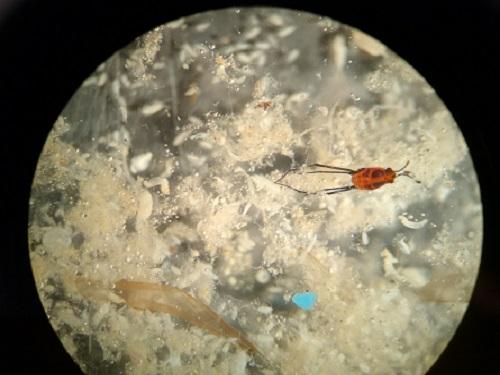Trawl of Red Sea surface waters finds little plastic

A raw sample before sorting, showing one piece of blue plastic. Credit: © 2017 Cecilia Martin
Samples of floating plastic rubbish were collected by the team from 120 sites along 1500km of shoreline on the eastern margin of the Red Sea during voyages in 2016-2017. The debris was captured in plankton nets dragged slowly just below the sea surface and the fragments were then painstakingly sorted into material type and size.
Three-quarters of the collected rubbish was rigid fragments of broken objects. Plastic film, such as bags or wrapping, made up 17% percent, but there were only small amounts of fishing lines or nets (6%) and foam (4%).
The relatively low levels of floating plastic in the Red Sea may either be due to there being fewer sources of rubbish or its faster removal, explains doctoral student, Cecilia Martin. Not much plastic comes from the land because this coastline has few of the usual polluting contributors.
“Usually the main source of plastic in the sea tends to be litter and mismanaged waste,” says Martin. “But on this coastline, the only large human settlement is Jeddah, with a population of 2.8 million people, and little tourism, so there are few people with the opportunity to litter.” Similarly, rivers globally provide 10-50% of discarded oceanic plastic, but because the Red Sea catchment has no permanent rivers, their contribution is negligible.
“Instead, the winds and a few storms are most probably the main sources of plastic,” says Martin. “This is reflected in our findings of proportionally higher amounts of plastic films compared to global trends.”
There is a concern, however, says Martin, about the “missing” plastic. The low levels of debris can be partially attributed to its “'removal” by the extensive mangrove and coral reef systems of the area. Capture of plastics is problematic for these ecosystems.
“Mangroves are perfect traps for macrolitter,” says Martin. “At high tide, floating items reach the forest and then, as the tide drops, get stuck in seedlings and mangrove aerial roots (pneumatophores) which act as a mesh to trap them.”
Coral ecosystems can also consume plastic. “The small size of microplastic items makes it available to a wide range of organisms and many marine groups, such as corals, mollusks, crabs and plankton are found to ingest plastic.”
Duarte says the problem of plastic pollution in the ocean reflects our consumer habits and the solution is to reduce plastic use in our daily lives.
Media Contact
All latest news from the category: Ecology, The Environment and Conservation
This complex theme deals primarily with interactions between organisms and the environmental factors that impact them, but to a greater extent between individual inanimate environmental factors.
innovations-report offers informative reports and articles on topics such as climate protection, landscape conservation, ecological systems, wildlife and nature parks and ecosystem efficiency and balance.
Newest articles
Humans vs Machines—Who’s Better at Recognizing Speech?
Are humans or machines better at recognizing speech? A new study shows that in noisy conditions, current automatic speech recognition (ASR) systems achieve remarkable accuracy and sometimes even surpass human…

Not Lost in Translation: AI Increases Sign Language Recognition Accuracy
Additional data can help differentiate subtle gestures, hand positions, facial expressions The Complexity of Sign Languages Sign languages have been developed by nations around the world to fit the local…

Breaking the Ice: Glacier Melting Alters Arctic Fjord Ecosystems
The regions of the Arctic are particularly vulnerable to climate change. However, there is a lack of comprehensive scientific information about the environmental changes there. Researchers from the Helmholtz Center…



